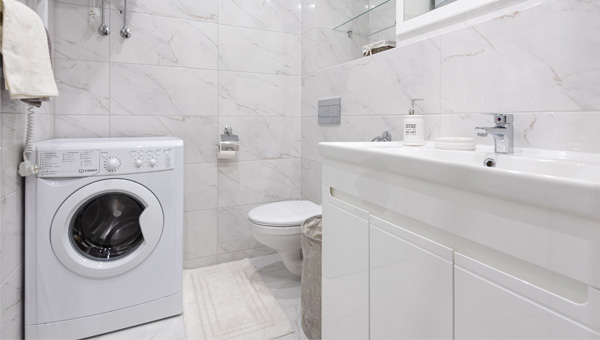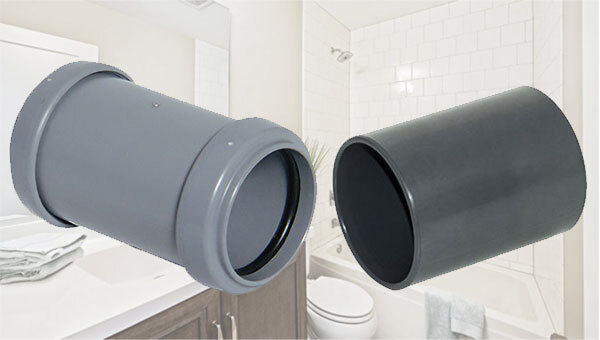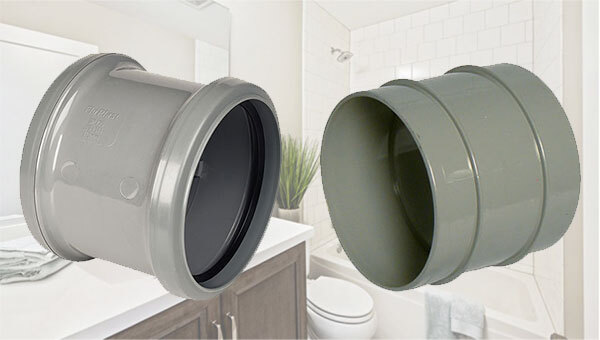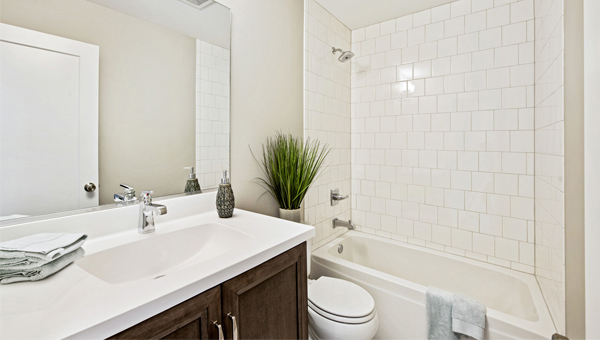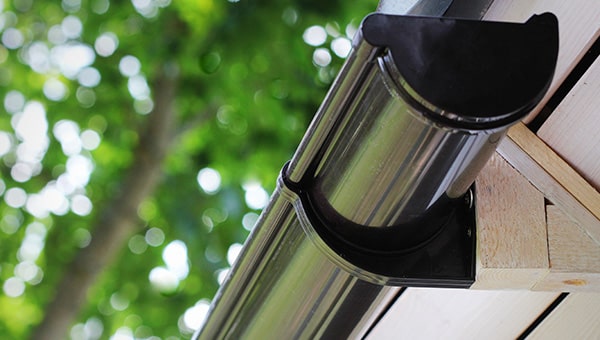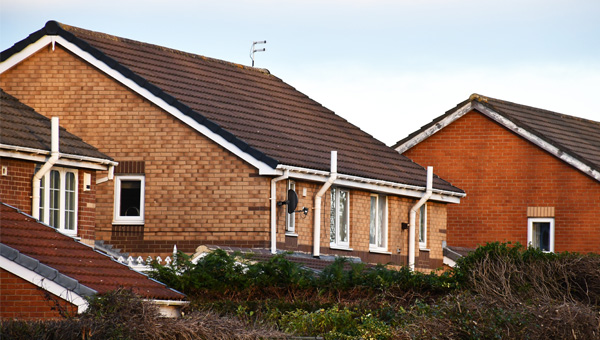
Soil and waste systems are networks of pipes that run throughout our homes, places of work, restaurants, entertainment venues, public areas, and pretty much any other place you can think of that has need of restrooms, washrooms, or kitchens. If water is used for any purpose, it needs somewhere to go afterwards. Connected to our toilets, sinks, bathtubs, and washing machines, soil and waste systems provide that means of disposal.
When installing these systems, however, care must be taken to ensure they are properly equipped to do their job safely and efficiently. Assuming that all the pipes and fittings have been securely connected together, and are therefore suitably watertight, the two main problems that need addressing in soil and waste systems are the venting of harmful gases, to keep us safe, and the balancing of air pressure in the pipes, to avoid the siphoning effect. Let's take a look at each one in more detail to better understand the solutions available.
Problem One: Harmful Gases in Soil Systems
Let's face facts...bodily waste smells! It's no big secret, despite society's best efforts to make it something one shouldn't discuss in polite conversation. In the world of plumbing and drainage, however, there's no room for beating about the bush. We all go to the toilet and we all expel unpleasant-smelling waste from our bodies. Bacteria that aids digestion, and the byproducts of that process, remain in our waste even after leaving our bodies. These are the leading cause of those nasty niffs - hence why we flush it all away as quickly as we can...and maybe spray a bit of air freshener around if we're being considerate. These smells and gases don't just disappear down into the sewer, however. While the waste that creates them should be transported fairly rapidly out of your soil system, the gases can linger and build up in the pipes.
Not only that, but our soil and waste systems connect to the mains sewer (unless you have an off-mains system), which means that gases produced by everyone else's waste in your street can float up through your pipes. While they do not generally pose a significant health risk in low concentrations, exposure to certain chemicals that can be present (such as hydrogen sulfide) can irritate your eyes, give you a sore throat or cough, and cause shortness of breath. However, prolonged exposure to, or higher concentrations of, these chemicals and gases can be a much more severe health risk. Hydrogen sulfide and methane build-up can even be an explosion risk since both are highly flammable.
Fortunately, we are generally saved from being subjected to the olfactory affront, and any potential health risks, of such gases by our wastewater traps (i.e. the U-bend, as they are most commonly, though not always correctly, identified). However, that doesn't stop them from still lingering in the pipes, just waiting for our next problem to occur and let them escape into our homes.
Problem Two: The Siphoning Effect in Soil and Waste Systems
Water pipes always have air in them, drawn into and carried along them anytime a toilet is flushed, or a tap is run. That in itself isn't the problem; the problem is the change in pressure that this causes. Under normal circumstances, the air in a drainage system sits at a neutral (atmospheric) pressure. Whenever there is a sudden flow of water, however, it pushes the existing air down the pipe ahead of it and draws more in behind it. This creates a positive pressure in front of the flow and a negative pressure behind. Without any means of balancing the pressure change, this can have one of two outcomes.
In extreme cases, positive pressure downstream in a system, especially in high rise buildings, can force water back up through the pipes and into your appliances, which can obviously be a health hazard. More common, however, is the problem caused by the negative pressure...a problem called the siphoning effect.
When there is a build-up of negative pressure in the system, more air is drawn in to try and correct the balance from any available opening. If a suitable option hasn't been installed in the system, the air will be pulled in from the plugholes in your sinks, bathtubs and showers. When this happens, it causes the water in traps to be siphoned out...hence the name. Without these little pockets of water providing an impenetrable gas barrier, foul odours from the drains can easily escape out into your home.
Okay, now we have a clearer understanding of these two common problems in soil and waste systems, let's take a look at our titular products to see how they can help.
A Vent Horizon - the open-air solution
Traditionally, the easiest way to solve both of these problems was with a Vent Pipe in the soil stack. Today, that is still very much the case...at least for most situations.
What is a Soil Vent Pipe?
When you scan your eyes across the horizon on any housing estate in the UK, you are almost certain to see a soil vent pipe sticking up above the roofline on at least a few of the properties. Soil vent pipes, toilet vent pipes, or drain waste vents are all just fancy names for the section of the soil stack that sits above the highest wet point in the property and leaves the system open to the atmosphere. It is usually just an ordinary length of soil pipe fitted with a wire cage, vent terminal, or other perforated cover to prevent debris or pesky birds from blocking it.
How does a Soil Vent Pipe work?
Because the vent pipe is open to the outside air, it allows the harmful gases to safely escape from within. It also provides a permanent opening for air to be pulled in to balance any pressure issues. With a vent pipe installed, no air needs to be pulled into the system from your appliances, meaning that your wastewater traps are safe from being siphoned. Thus can both of our problems be addressed with one length of pipe.
Where can a Soil Vent be installed?
Due to vent pipes allowing sewer gases to escape out into the atmosphere, there are strict building regulations that must be followed when installing one. A soil vent pipe must always terminate above the property's roofline and be at least 900mm higher than any window or opening within 3 meters of the pipe. For most properties, this means that the vent pipe will either need to be installed up through the roof, for an internal soil stack, or stick up like a long snorkel above the level of your gutters, if the soil stack runs up an external wall.
If, however, a property has had its loft converted and a dormer window installed, for example, installing a vent pipe that still meets the building regulations can be difficult. Also, there are some properties that still have separate soil and waste systems, meaning the pipes that connect the sinks, baths, showers, and washing machines to the main drains don't run through the soil stack. Though the waste pipes don't need to vent out any gases, they will still suffer from the siphoning effect if air can't be drawn in from an alternate source. This is where our second solution comes in handy.
Under Pressure – bringing balance without the smell
A modern alternative to solving the pressure problem in soil and waste systems is through the use of Air Admittance Valves.
What is an Air Admittance Valve?
Air Admittance Valves, sometimes called Durgo Valves, are one-way air valves that can be installed instead of Soil Vent Pipes, or sometimes in addition to them, to help keep the pressure in soil and waste systems balanced.
How does an Air Admittance Valve work?
Air Admittance Valves are very cleverly designed to allow the free entry of air into the pipework system without allowing any foul odours or gases to escape out. They achieve this through the use of a diaphragm that keeps the valve closed under normal atmospheric pressure (or if pushed up by positive pressure in the system) but opens it when pulled down by negative pressure in the system.
Where can an Air Admittance Valve be installed?
Because Air Admittance Valves don't allow foul odours and harmful gases to leave the system, they can (and in most cases should) be installed inside of the property. As long as it is installed vertically, is at least 200mm above the highest water entry point, and has plenty of space for the air to flow around it, the valve can be hidden away up in the loft or inside a cupboard.
What is a Durgo Valve?
The term "Durgo valve" is often used to refer to air admittance valves (AAV) in general, likely due to the fact that Durgo valves were one of the first brands of AAVs on the market, and they quickly gained a reputation for their reliability and durability. Developed in Sweden in the 1960s, Durgo valves were introduced as a way to vent drainage systems in buildings where it was not possible to install a traditional vent stack. They quickly gained a reputation for their reliability and durability and were eventually introduced to other markets around the world.
It is common to still hear “Durgo Valve” being used as a common term for Air admittance valves, much in the same way that many people still say they are going to “do the hoovering” even if they don’t have a Hoover-branded vacuum cleaner. Durgo valve is also relatively short and easy to remember, which makes it a convenient term to use when referring to AAVs. In the years since the Durgo Valve was first released, however, many other brands have hit the market with air admittance valves designed to be as equally durable and reliable in preventing sewer gases from entering a building while still allowing air to enter the soil pipe to keep the pressure balanced. At JDP, we stock a select range of air admittance valvesfor use with 110mm soil pipe systems.
As you can see, both vent pipes and air admittance valves are capable of solving the pressure problem, but only one can be used to release the harmful gases. This then leads us to our next big question...does every soil system need a Vent Pipe?
To Vent or Not to Vent - when are vent pipes needed in soil and waste systems?
Let's get one thing clear straight off the bat...if your property uses a sewage treatment plant, septic tank, or cesspool instead of a connection to the mains drains, there must be AT LEAST one open vent in the system to prevent a dangerous build-up of gases. Air Admittance Valves can be installed in addition to, but should never be installed in place of a vent pipe for off-mains systems.
So, with that out of the way, the question here is, if you are connected to the mains drains, does your soil stack need to be vented? The answer to that is, conditionally, no. Technically speaking, having a soil system that can't release gases out of a vent pipe isn't a problem...just so long as there is a suitable vent elsewhere to release gases from the system. This can be located at a safe distance from the property and still comply with regulations. However, more often than not, what this actually means is that at least one house in a row of 5 on the same drainage run must be vented to avoid dangerous build-ups. If you were planning to remove a vent pipe to replace it with an air admittance valve, you must make sure that your property isn't that 1-in-5 house before doing so. As long as you've ensured the rule of five is unbroken, you should be able to install an Air Admittance Valve instead of a Vent Pipe on a property up to three stories high.
The next question then is...why would you want to?
When is a Valve better than a Vent?
The primary purpose of both vents and valves is to regulate the pressure in the drainage system and, in this, they both perform equally well. The only real difference is in how they can be installed, and that's where an AAV can nose its way into the lead.
Where can an Air Admittance Valve be installed?
The primary advantage of using an Air Admittance Valve instead of a vent pipe at the top of your soil stack is the fact that it doesn't need to stick up above the roofline. The regulations on the height of a soil vent pipe termination point can result in an unsightly pipe sticking out above the level of the eaves on some properties. Internal soil stacks require a hole in the roof for the pipe to pass through, which has to then be fitted with a weathering slate and weathering collar to make it watertight. For external soil stacks, it also requires working at height to install, which is never advisable without the use of professional scaffolding. All of this adds to the time and cost of your installation that can otherwise be saved if you use an AAV instead.
Also, as mentioned earlier, if your property has separate soil and waste systems that don't join up until they reach the main drain, a vent pipe in the soil stack will not prevent pressure issues in the waste system. If your toilet system works fine, but you often get a gurgling sound from your sinks, this could be why.
Problems with siphonage can often arise in properties that have been extended in some way and had additional appliances installed that require drainage connections. The maximum distance any appliance water trap should be from the discharge stack (in accordance with BS EN 12056-2: 2000 paragraph 6.4.3 Table 10 and Figure 9 Ventilated Branches) is 4 meters. Any further than that, and the soil vent pipe alone will not be sufficient enough to prevent the siphoning effect. Installing an Air Admittance Valve within 1.5 meters of an appliance trap, however, solves that problem entirely. In this respect, Air Admittance Valves can be thought of as vent pipe backups rather than straight-up replacements.
Other benefits to using Air Admittance Valves on internal soil stacks include the prevention of heat being lost through an otherwise constantly open vent, and the reduced risk of condensation building up on surfaces around the internal vent stack. Last but by no means least, an Air Admittance Valve can provide a secondary rodding point for your system in case of blockages.
As you can see, the advantages of using them are many but, as with all things, there are also some disadvantages.
What are the disadvantages of using an Air Admittance Valve instead of a Vent Pipe?
The main problem with using an Air Admittance Valve instead of a Soil Vent Pipe, as discussed earlier, is that by preventing the gases from escaping through the top of the soil stack you are causing them to be forced down into the main drains and sewer system instead. If every property on that mains system had AAV's instead of soil vent pipes, it would cause a lot of problems.
For this reason, there are also a number of caveats to where and when Air Admittance Valves can or can't be used, and they can vary depending on whether your property falls under the building regulations for England & Wales, Scotland, or Northern Ireland. For these reasons, we would highly recommend consulting the appropriate documentation before finalising your installation plans. The technical documentation from Floplast, provided on our Air Admittance Valve product pages, is a good place to start.
In general, most limitations come down to how many other properties are linked to the same sewer mains as yours and how many stories your soil and waste system has to service. The table below gives some basic guidance:
| Air Admittance Valve Disposition | ||
|---|---|---|
| Number of Dwellings | Up to three stories in height | Multi-storey domestic dwelling and non-domestic buildings |
| 1-4 | Additional drain and venting not required. | Conventional drain venting to be provided if more than one such building, each equipped with the valves, is connected to a common drain which is not itself vented by means of a ventilation stack or discharge stack not fitted with a valve. |
| 5–10 | Conventional ventilation (open-topped discharge stack) to be provided at the vent stack at the head of the installation. | |
| 11–20 | Conventional ventilation (open-topped or discharge stack) to be provided at the vent stack at the head of the installation and at mid-point of the system. | |
information provided by FloPlast.
The other potential problem with using an AAV instead of a vent pipe is that if you ever get a blockage in the system that prevents the gasses from being pushed down into the sewer, those gases will have nowhere else to go. It is therefore imperative that, if you have such a system, you make sure to act on even the faintest sign of a blockage and get it resolved quickly.
Aside from this, however, as long as it has been installed properly and conforms to the relevant building regulations, installing an Air Admittance Valve alongside, or instead of, a Soil Vent Pipe can save you time, money, and mess while still protecting your wastewater traps from being siphoned. You just have to remember the rule of five and make sure yours isn't the last vent pipe standing.
And there you have it, our advice on the use of Soil Vent Pipes and Air Admittance Valves. We hope it has been informative. Once you've decided which option is best for your system, the next step is to buy the parts you need and get them installed. If you're looking for high-quality plastic systems, we've got you covered with our full range of Floplast soil & waste pipes and fittings, including soil pipe AAV's and waste pipe AAV's.
For a more general overview of soil and waste systems, take a look at our Basic Guide to Soil & Waste Systems. Should you have any questions or need any further advice about valves, vents or soil and waste systems, though, check out our Soil & Waste FAQ article or contact JDP today. Our team of experts are always on hand to help with all of your drainage needs.


